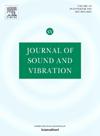Gas turbine harmonic detection and modal identification based on underdetermined blind source separation
IF 4.3
2区 工程技术
Q1 ACOUSTICS
引用次数: 0
Abstract
In gas turbine operational modal parameter identification, traditional methods like operational modal analysis or underdetermined blind source separation (UBSS) struggle with underdetermined time-delay mixture and harmonic interference. Based on the signal sparsity in the energy domain, this paper proposes a novel method based on improved UBSS with binary time-frequency masking (BTFM). First, signals are transformed to the time-frequency domain, and then to the energy domain by integrating over time. And peak frequency points are detected frequency energy sum curve from each channel. Second, to distinguish source signals, cosine distances between peak frequency points and other ones are calculated, and BTFM is constructed. Third, source signals are recovered and padding lines are added to reduce boundary effects. Finally, to detect harmonic components in the source signals, the probability density and kurtosis of each signal are calculated. Based on the separated modal response signals, the modal frequency of each order is identified, and the modal modes are determined using the mixing matrix. The effectiveness of the proposed method is validated through comprehensive analysis on a simulation system, a three-rotor test bench, and gas turbine datasets. Results show that it outperforms existing methods in achieving more accurate and reliable modal identification under harmonic interference. The proposed method facilitates operational modal identification and condition monitoring for large-scale equipment such as gas turbines, thereby providing guidance for structural optimization and vibration/noise reduction.
基于欠定盲源分离的燃气轮机谐波检测与模态识别
在燃气轮机运行模态参数辨识中,传统的运行模态分析或欠定盲源分离(UBSS)等方法都要与欠定时滞混合和谐波干扰作斗争。基于信号在能量域中的稀疏性,提出了一种基于二值时频掩蔽(BTFM)的改进UBSS方法。首先,将信号转换到时频域,然后通过时间积分转换到能量域。检测各通道的峰值频率点的频率能量和曲线。其次,为了区分源信号,计算峰值频率点与其他频率点之间的余弦距离,构造BTFM;第三,对源信号进行恢复,并加入填充线以减小边界效应。最后,为了检测源信号中的谐波成分,计算每个信号的概率密度和峰度。基于分离的模态响应信号,识别各阶模态频率,利用混合矩阵确定模态模态。通过仿真系统、三转子试验台和燃气轮机数据集的综合分析,验证了该方法的有效性。结果表明,该方法在谐波干扰下的模态识别更加准确、可靠。该方法有助于燃气轮机等大型设备的运行模态识别和状态监测,从而为结构优化和减振降噪提供指导。
本文章由计算机程序翻译,如有差异,请以英文原文为准。
求助全文
约1分钟内获得全文
求助全文
来源期刊

Journal of Sound and Vibration
工程技术-工程:机械
CiteScore
9.10
自引率
10.60%
发文量
551
审稿时长
69 days
期刊介绍:
The Journal of Sound and Vibration (JSV) is an independent journal devoted to the prompt publication of original papers, both theoretical and experimental, that provide new information on any aspect of sound or vibration. There is an emphasis on fundamental work that has potential for practical application.
JSV was founded and operates on the premise that the subject of sound and vibration requires a journal that publishes papers of a high technical standard across the various subdisciplines, thus facilitating awareness of techniques and discoveries in one area that may be applicable in others.
 求助内容:
求助内容: 应助结果提醒方式:
应助结果提醒方式:


